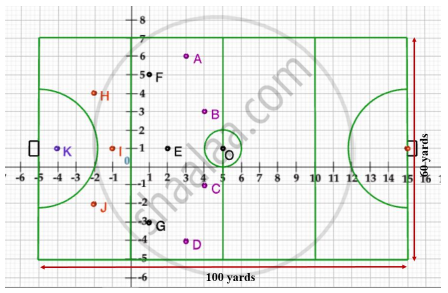Advertisements
Advertisements
Question
Points A (-3, -2), B (-6, a), C (-3, -4) and D (0, -1) are the vertices of quadrilateral ABCD; find a if 'a' is negative and AB = CD.
Solution
AB = CD
AB2 = CD2
(- 6 + 3)2 + (a + 2)2 = (0 + 3)2 + (- 1 + 4)2
9 + a2 + 4 + 4a = 9 + 9
a2 + 4a - 5 = 0
a2 - a + 5a - 5 = 0
a(a - 1) + 5 (a - 1) = 0
(a - 1) (a + 5) = 0
a = 1 or - 5
It is given that a is negative, thus the value of a is - 5.
APPEARS IN
RELATED QUESTIONS
Show that the points (a, a), (–a, –a) and (– √3 a, √3 a) are the vertices of an equilateral triangle. Also find its area.
Find the coordinates of the circumcentre of the triangle whose vertices are (8, 6), (8, – 2) and (2, – 2). Also, find its circum radius
ABC is a triangle and G(4, 3) is the centroid of the triangle. If A = (1, 3), B = (4, b) and C = (a, 1), find ‘a’ and ‘b’. Find the length of side BC.
Two opposite vertices of a square are (-1, 2) and (3, 2). Find the coordinates of other two
vertices.
Using the distance formula, show that the given points are collinear:
(-1, -1), (2, 3) and (8, 11)
Find the distance between the following pair of points.
R(0, -3), S(0, `5/2`)
Determine whether the point is collinear.
P(–2, 3), Q(1, 2), R(4, 1)
Find the distances between the following point.
P(–6, –3), Q(–1, 9)
Find the distance between the following pairs of point in the coordinate plane :
(4 , 1) and (-4 , 5)
Find the distance of the following point from the origin :
(5 , 12)
Find the distance between the following point :
(p+q,p-q) and (p-q, p-q)
Find the value of a if the distance between the points (5 , a) and (1 , 5) is 5 units .
Find the distance between the origin and the point:
(8, -15)
Find the co-ordinates of points on the x-axis which are at a distance of 17 units from the point (11, -8).
A point A is at a distance of `sqrt(10)` unit from the point (4, 3). Find the co-ordinates of point A, if its ordinate is twice its abscissa.
A point P lies on the x-axis and another point Q lies on the y-axis.
Write the abscissa of point Q.
KM is a straight line of 13 units If K has the coordinate (2, 5) and M has the coordinates (x, – 7) find the possible value of x.
Case Study -2
A hockey field is the playing surface for the game of hockey. Historically, the game was played on natural turf (grass) but nowadays it is predominantly played on an artificial turf.
It is rectangular in shape - 100 yards by 60 yards. Goals consist of two upright posts placed equidistant from the centre of the backline, joined at the top by a horizontal crossbar. The inner edges of the posts must be 3.66 metres (4 yards) apart, and the lower edge of the crossbar must be 2.14 metres (7 feet) above the ground.
Each team plays with 11 players on the field during the game including the goalie. Positions you might play include -
- Forward: As shown by players A, B, C and D.
- Midfielders: As shown by players E, F and G.
- Fullbacks: As shown by players H, I and J.
- Goalie: As shown by player K.
Using the picture of a hockey field below, answer the questions that follow:

What are the coordinates of the position of a player Q such that his distance from K is twice his distance from E and K, Q and E are collinear?
Find the distance between the points O(0, 0) and P(3, 4).
A point (x, y) is at a distance of 5 units from the origin. How many such points lie in the third quadrant?
